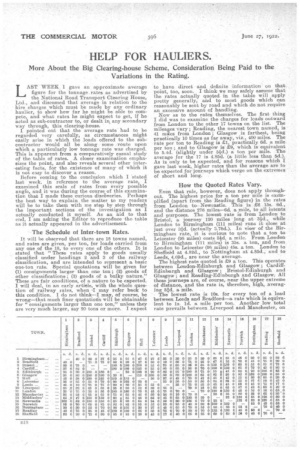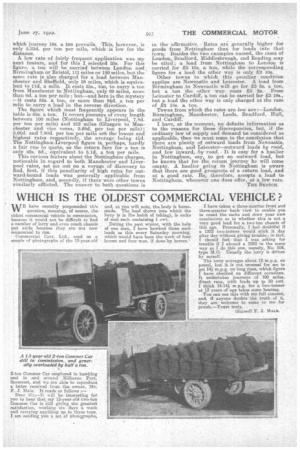HELP FOR HAULIERS.
Page 16

Page 17

If you've noticed an error in this article please click here to report it so we can fix it.
More About the Big Clearing-house Scheme, Consideration Being Paid to the Variations in the Rating.
LAST WEEK I gave an approximate average figure for the tonnage rates as advertised by the National Road Transport Clearing House, Ltd., and discussed that average in relation to the hire charges which must be made by any ordinary haulier, to sho* how far he might be able to compete, and what rates he might expect to get, if he acted as sub-contractor to, or dealt in any secondary way through, this clearing-house.
I pointed out that the average rate had to be regarded very carefully, as circumstances might easily arise in which the loads offered to the subcontractor would all be along some route upon which a particularly low tonnage rate was charged. This is apparent from a comparatively casual stady of the table of rates. A closer examination emphasizes the point, and also reveals several other interesting facts, for the existence of many of which it is not easy to discover a reason.
Before coming to the conclusion which I "stated last week, in reference to the average rate, I examined this scale of rates from every possible angle, and it was during the course of this examination that I made these curious discOveries. Perhaps the best wal to explain the matter to my readers will be to take them with me step by step through the important sections of the investigation as I actually conducted it myself. As an aid to that end, I am asking the Editor to reproduce the table as it actually appeared in the advertisement.
The Schedule of Inter-town Rates.
It will be observed that there are 18 towns named, and rates are given, per ton, for loads carried from any one of the 18, to every one of the others. It is stated that " These rates apply to goods usually classified under headings 2 and 3 of the railway classification, and are intended to represent a basic one-ton rate. Special quotations will be given for (1) consignments larger than one ton ; (2) goods of other classifications-. (3) goods of a bulky nature." These are fair conditions, of a nature to be expected. I will deal, in an early article, with the whole question of railway rates, when I may refer back to this condition. I do not think—I may, of course, be wrong—that much finer quotations will be obtainable for "consignments larger than one ton," unless they are very much larger, say 20 tons or more. I expect
to have direct and definite information on that point, too, soon. I think we may safely assume that the rates actually quoted in the table will apply pretty generally, and to most goods which can reasonably be sent by road and which do not require an excessive amount of handling.
Now as to the rates themselves. The first thing I did was to examine the charges for loads outward from London to the other 17 towns on the list. The mileages vary ; Reading, the nearest town named, is 41 mites from London • Glasgow is farthest, being practically 10 tunes London; away, viz., 400 miles. The rate per ton to Reading is 21, practically 6d. a mile per ton ; and to Glasgow is 29, which is equivalent to 5.4d. (slightly under 50.) a ton per mile. The average for the 17 is 4.85d. (a little less than 5d.). As is only to be expected, and for reasons which I gave last week, higher rates than the average are to be expected for journeys which verge on the extremes . of short and long.
How the Quoted Rates Vary.
Even that rule, however, does not apply throughout. The highest price for a ton per mile is exemplified (apart from the Reading figure) in the rates from London to. Newcastle. This is 26 15s. 6d., and the distance 276 miles-6d. a mile, to all intents and purposes. The lowest rate is from London to Bristol, a journey 120 miles long at 3-id., while London to Birmingham (111 miles) runs it close at just over 3id. (actually 3.78d.). In view of the Birmingham rate, it is curious to note that a ton to Leicester (98 miles) costs 50. a mile. From London to Birmingham (111 miles) is 33s. a ton and from London to Leicester (98 miles) 45s. a ton. 'London to Sheffiekl at 4.82d., to Nottingham at 4.85d., and to Leeds,. 4.69d., are near the average_ The highest rate quoted is 29 a ton. This operates between London-Edinburgh and Glasgow ; CardiffEdinburgh and Glasgow Bristol-Edinburgh and Glasgow ; and Reading-Edinburgh and Glasgow. All these journeys are, of course, near the upper extreme of distance, and the rate is, therefore, high, averaging 5.id. a mile. The lowest rate is 10s. for every ton of a load between Leeds and Bradford—a rate which is equivalent to is. id. a mile per ton. Another low total rate prevails between Liverpool and Manchester, on
which journey 16s. a ton prevails. This, however, is only 5.33d. per ton per mile, which is low for the distance.
A low rate of fairly frequent application was my next feature, and for this I selected 35s. For this figure. a ton will be earned between London and Birmingham or Bristol, 111 miles or 120 miles, but the same rate is also charged for a load between Manchester and Sheffield, only 38 miles, which is equivalent to 11d, a mile. It costs 35s., too, to carry a ton from Manchester to Nottingham, only 69 miles, more than 6d. a ton per mile ; but—and here is the mystery —it costs 55s. a ton, or more than 90. a ton per mile to carry a load in the reverse direction. . The figure which most frequently appears in the table is 65s. a ton. It covers journeys of every length between 100 miles (Nottingham to Liverpool, 7.8d. per ton per mile) and 212 miles (Glasgow to Manchester and vice versa, 3.68d. per ton per mile); 3.68d. and 7.80d. per ton per mile are the lowest and highest rates respectively, the average being 44d. The Nottingham-Liverpool figure is, perhaps, hardly a fair one to quote, as the return fare for a ton is only 42s. 6d., equivalent to 5.1d. a ton per mile. This curious feature about the Nottingham charges, noticeable in regard to both Manchester and Liverpool rates, set me out on a voyage of discovery to find, first, if this peculiarity of high rates for outward-bound loads was generally applicable from Nottingham and, secondly, if there were other towns similarly afhieteel. The answer to both questions is in the affirmative. Rates are generally higher for goods from Nottingham than for loads into that town. Besides the two examples named, the cases of London, Bradford, Middlesbrough, and Reading may be cited ; a load from Nottingham to London is carried for 23 10s. a ton, while the corresponding figure for a load the other way is only .22 10s. Other towns to which this peculiar conditioo applies are Newcastle and Leicester. A load from Birmingham to Newcastle will go for 23 6s. a ton, but a ton the other way. costs 25 2s. From Leicester to Cardiff, a ton can be carried for 23 10s., but a load the other way is only charged at the rate of 22 15s. a ton.
Towns from which the rates are /ow are:—London, Birmingham, Manchester, Leeds, •Bradford, Hull, and Cardiff.
I have, at the moment, no definite information as to the reasons for these discrepancies, but, if the ordinary law of supply and demand be considered as applicable, then we must, come to the conclusion that there are plenty of outward loads from Newcastle, Nottingham, and Leicester—outward loads by road, and few inward, by road. It is easy for a haulier in Nottingham, say, to get an outward load, but he knows that for the return journey he will come empty. A haulier going to Nottingham is aware that there are good prospects of a return load, and at a good rate. He, therefore, accepts a. load to Nottingham, whenever one does offer, at a low rate.






























